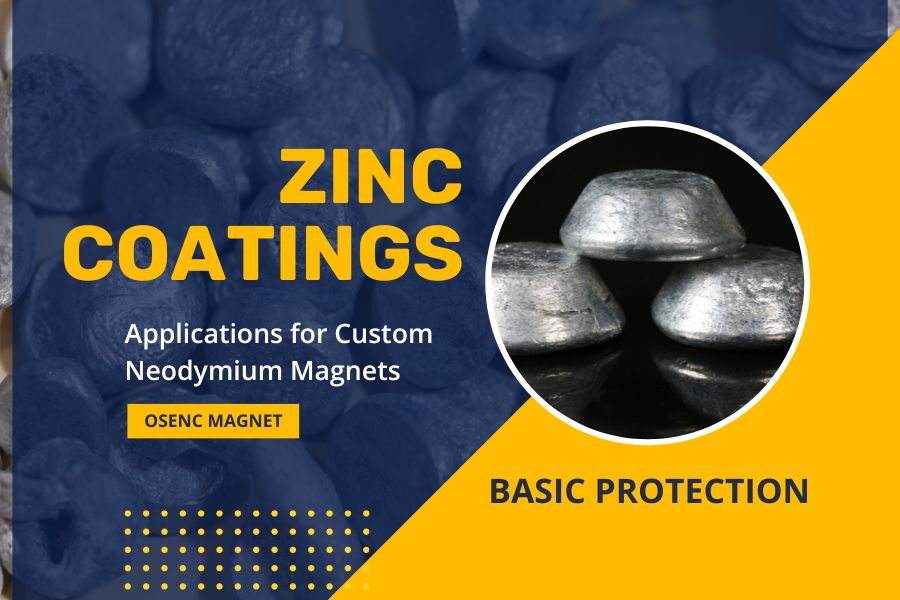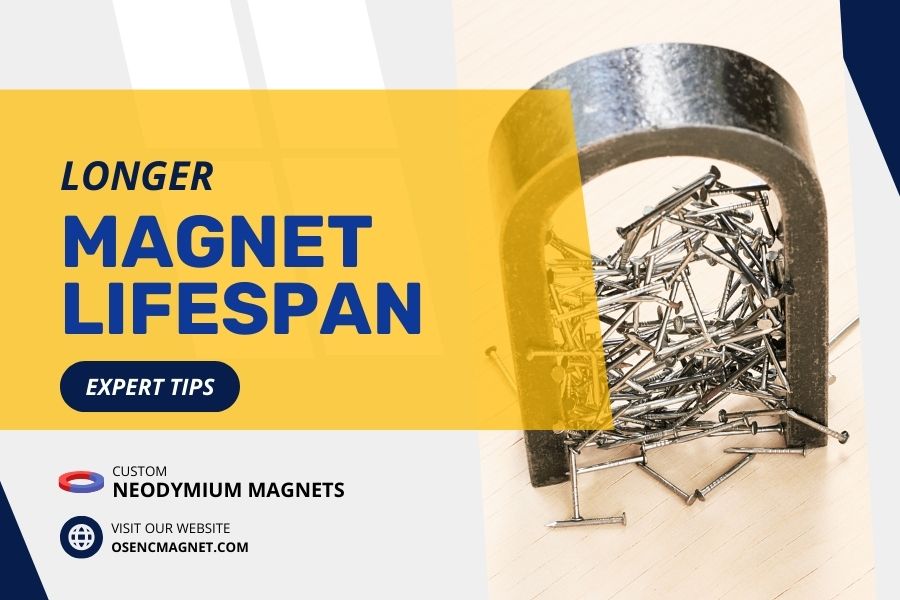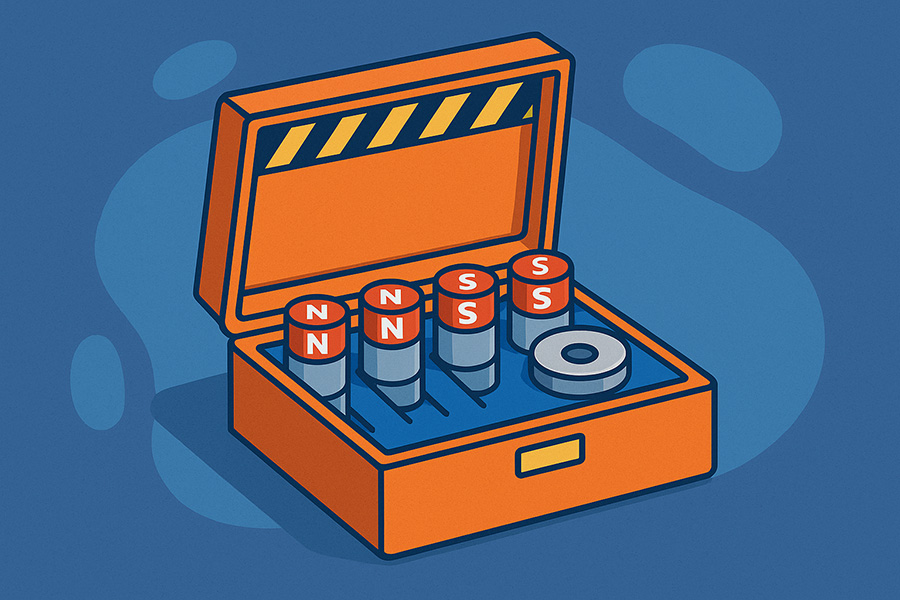Working with neodymium magnets requires protecting them from corrosion.
Over time, exposure to moisture and corrosive elements can degrade the magnet’s performance.
It can also shorten its lifespan.
That’s where zinc plating comes in.
It is a common and economical protective coating.
It offers several key benefits for your magnets.
Let’s dive into what zinc plating is.
Table of Contents
Why Neodymium Magnets Need Protection
Neodymium magnets are incredibly strong.
But they have a big problem. They rust easily.
These magnets contain lots of iron. This makes them prone to rust. Their structure has tiny pores that let moisture seep in.
While neodymium is reactive, it’s actually the iron that speeds up rust. Without protection, your magnets can:
- Lose strength as the surface oxidizes
- Develop flaking and partial demagnetization
- Break more easily when stressed
- Fall apart in harsh environments
A bare neodymium magnet will start rusting within days or even hours in humid conditions.
That’s why almost all commercial neodymium magnets have some protective coating.
Types of Zinc Plating Finishes
After zinc plating, manufacturers apply chromate coatings that affect both looks and performance. These create a protective film that boosts corrosion resistance.
Blue-White (Clear) Zinc
This finish gives magnets a shiny silver or slight bluish look. It uses trivalent chromium (Cr³⁺) which is environmentally friendly and RoHS-compliant. Clear zinc offers the lowest protection among color options – about 12-24 hours in salt spray testing before white corrosion appears. It’s the most common finish because of its attractive metallic look and safety compliance.
Yellow Chromate Zinc
This coating has a gold or yellow color. Modern versions use trivalent chromium formulas that match the traditional look while meeting safety rules. Yellow zinc gives superior protection – typically 96-120 hours in salt spray testing. It’s perfect for outdoor use or moderate exposure.
Black Zinc
This dark finish ranges from olive-green to jet black. Black zinc is chosen for looks (reducing glare or color-coding) and function. With advanced formulas, it can protect as well as yellow chromate. Modern black zinc uses trivalent passivates with extra sealants, providing high protection without toxic chemicals.
Olive Drab Zinc
This greenish-brown coating was traditionally used for military specs. It creates a dull green look useful for camouflage and indicates a thicker chromate film with very high corrosion resistance. Olive drab zinc coatings excel in salt spray tests, making them good for harsh environments.
Most modern zinc platings use trivalent chromate coatings instead of older hexavalent formulas, making them safer and compliant with environmental rules like RoHS. The performance of modern trivalent coatings has improved greatly, often matching or exceeding older hexavalent types when used with proper sealers.
The Zinc Coating Process
Most manufacturers use electroplating to apply zinc coatings. The process follows several precise steps:
- The magnets get thoroughly cleaned to remove dirt
- They may receive a “strike” coat for better adhesion
- The magnets become cathodes in an electrolytic bath with zinc ions
- Electric current deposits zinc onto the magnet surface
- A uniform zinc layer forms
- A chromate conversion coating is applied for extra protection
This method coats magnets evenly with controlled thickness. It works well for batch production of custom magnets.
Typical zinc coating thickness ranges from 5-10 micrometers (μm). Thicker coatings (12-25 μm) may be used for magnets that will face harsher conditions.
Quality Indicators for Zinc Plating
High-quality zinc plating should have these characteristics:
Appropriate Thickness
The zinc layer must be thick enough to provide good protection. Industry standards like ASTM B633 define zinc plating classes by thickness:
- Fe/Zn 5: 5 micrometers (μm)
- Fe/Zn 8: 8 micrometers (μm)
- Fe/Zn 12: 12 micrometers (μm)
- Fe/Zn 25: 25 micrometers (μm)
Standard white/clear zinc coatings for magnets are typically 5-10 μm thick. For harsher environments, higher thickness classes (12-25 μm) work better. Very thick electroplated zinc (>25 μm) is uncommon on small magnets due to size and process limits.
Uniform Coverage
A quality coating covers the entire surface evenly, including edges and corners. Sharp edges tend to get thinner deposits during electroplating. Plating processes should use proper bath chemistry (acid vs. alkaline zinc) to improve “throwing power” and achieve even thickness. Well-plated magnets show consistent matte gray or bluish finish across all surfaces with no bare spots, pinholes, or weak areas where rust could start.
Strong Adhesion
The zinc must bond tightly to the magnet’s surface. Proper surface preparation (cleaning and possibly a nickel strike or other pretreatment) ensures the first layer bonds metallurgically. High-quality zinc plating stays intact when subjected to tape tests or light scratching. Poor adhesion leads to flaking or peeling, especially since neodymium magnets are very hard with little “give.” Once coating flakes off, the exposed magnet quickly rusts and damage can spread beneath the remaining plating.
Corrosion Resistance
Plating quality is measured by standardized corrosion tests, such as neutral salt spray (NSS) hours before white rust (corrosion of the zinc layer) or red rust (corrosion of the base metal) appears. Performance benchmarks include:
- Basic clear trivalent chromate: ~12-24 hours before white zinc oxide appears
- Standard zinc with yellow chromate: 72-96 hours before significant corrosion
- High-performance trivalent passivate: 96-120 hours before white rust
In real-world terms, a well-plated zinc-coated magnet should withstand normal indoor conditions for many years without rusting.
Advantages of Choosing Zinc-Plated Neodymium Magnets
Sacrificial Protection
Zinc shields your magnet even when scratched or damaged. It corrodes first, forming harmless white oxidation that keeps protecting the magnet beneath. This makes zinc especially valuable for applications where minor damage might happen.
Cost-Effectiveness
Zinc plating is the cheapest coating option for neodymium magnets. The process uses relatively inexpensive metals and common techniques. Among typical coatings, the price ranges from low to high: zinc < nickel < chrome/gold.
Decent Corrosion Resistance
For indoor applications, zinc provides enough protection. A well-applied zinc coating can last for years in normal indoor conditions. With proper chromate treatment, it can handle occasional moisture exposure.
Electrical Conductivity
The zinc layer conducts electricity well. This matters for certain electromagnetic applications or when the magnet forms part of an electrical circuit.
Adhesive Compatibility
Zinc-plated surfaces often bond stronger with adhesives than smoother finishes like nickel. This helps when magnets need to be glued into assemblies. The slight porosity of zinc helps certain adhesives “grab” the surface.
Variety of Finishes
With different chromate conversion coatings (clear, yellow, black), zinc plating offers aesthetic options. These finishes allow for color coding or matching the magnet to your design needs.
Limitations to Consider
Moderate Environmental Protection
Zinc offers less protection than nickel or epoxy in harsh environments. In continuous moisture or salt exposure, zinc will form white corrosion products and eventually be consumed. It may not be ideal for long-term outdoor or marine applications.
Temperature Sensitivity
Zinc plating is generally not good for high-temperature use. The coating can degrade when exposed to temperatures above 80°C for extended periods. For hot environments, other coatings might work better.
Softer Surface
Zinc is relatively soft compared to nickel (about one-third to one-half the hardness of steel). The thin zinc layer can wear through if the magnet slides or rubs against surfaces frequently. It offers minimal protection against denting on impact.
White Rust Formation
The sacrificial nature of zinc means it intentionally corrodes to protect the magnet. This corrosion appears as white zinc oxide “rust” – a powdery or chalky film on the surface. While protective, this can look unattractive in visible applications.
Less Shiny Appearance
Zinc generally has a duller, matte finish compared to the bright chrome-like shine of nickel plating. If a polished appearance is important, this could be a disadvantage.
Best and Worst Environments for Zinc-Plated Neodymium Magnets
Ideal Conditions
Zinc-plated magnets perform best in these environments:
- Dry indoor settings with normal room temperature and humidity
- Climate-controlled or sealed applications like inside electronic devices or enclosures
- Protected outdoor locations with infrequent moisture exposure (under awnings or only out in good weather)
- Environments free from abrasion where coating remains intact
- Situations with occasional moisture exposure that allows drying afterward – zinc’s sacrificial protection handles brief dampness well
In typical home, office, or workshop settings, zinc-coated magnets can last for many years without signs of rust. The zinc coating may form a stable patina after slight oxidation that prevents deeper rust even with occasional moisture exposure.
Challenging Conditions
Zinc plating struggles in these environments:
- High humidity settings like damp basements, greenhouses, or constantly humid climates
- Salt exposure in coastal/marine environments – salt acts as an electrolyte that dramatically speeds up zinc corrosion
- High temperatures above 80°C – prolonged exposure causes the chromate protective film to break down
- Thermal cycling – repeated heating and cooling can cause expansion mismatch between coating and magnet, potentially causing micro-cracks
- Chemical exposure – acids or strong alkalis attack zinc quickly; zinc dissolves in acid and forms soluble zincate in high pH (like bleach or lye)
- Mechanical wear situations – sliding, vibrating, or frequent rough handling removes the thin zinc layer at contact points
- High-friction or load-bearing interfaces where abrasion removes the coating
In these harsh conditions, the zinc coating will degrade much more quickly – potentially in weeks or months rather than years.
For salt spray environments, deterioration can be rapid (days to weeks) if the exposure is severe.
Comparing Zinc to Other Coating Options
Nickel-Copper-Nickel (Ni-Cu-Ni)
- Standard “tri-layer” coating widely used for neodymium magnets
- More corrosion-resistant than zinc, especially in harsh environments
- Harder surface (2-3 times harder than zinc) that resists scratches better
- Better heat resistance, suitable for higher temperature applications
- Bright, chrome-like appearance that maintains its shine longer
- Typical thickness of 15-25 μm (vs. 5-10 μm for zinc)
- Costs more than zinc coating (typically 20-30% higher)
- Not sacrificial – if scratched, the exposed magnet can rust quickly
- Potential concern for people with nickel allergies if the magnet contacts skin
Epoxy or Resin Coating
- Creates a nearly impermeable polymer barrier against moisture
- Excellent for harsh environments, including marine applications
- Non-conductive, preventing eddy currents in electromagnetic applications
- Less durable against physical abrasion than metal coatings
- Can chip under mechanical stress but sometimes able to keep broken magnet pieces together
- Often thicker than metal platings, affecting dimensional precision
- Good for applications where electrical isolation is required
Gold Coating
- Outstanding corrosion resistance and chemical inertness
- Biocompatible for medical applications and implantable devices
- Maintains appearance without tarnishing
- Very expensive compared to zinc (often 5-10x the cost)
- Rarely used except for specialized applications like medical devices
- Usually applied over a base layer of nickel for better adhesion
Zinc-Nickel Alloy
- Provides 5-10 times better corrosion resistance than pure zinc
- Maintains sacrificial protection properties
- Used extensively in automotive applications where salt spray performance is critical
- Can withstand higher temperatures than pure zinc plating
- More expensive than pure zinc but less than exotic coatings
- Standard in automotive parts that must meet strict corrosion resistance requirements
- Good option for demanding environments while maintaining cost control
Parylene Coating
- Ultra-thin (5-25 μm), conformal polymer coating
- Excellent moisture barrier with no pinholes
- Electrically insulating and chemically inert
- Applied through vapor deposition process
- Very expensive compared to electroplating options
- Used in medical and electronic applications where reliability is critical
Industry-Specific Applications
Consumer Electronics
Zinc-plated magnets work well in devices like speakers, haptic motors, and computer hard drives. The controlled indoor environment and cost sensitivity of electronics manufacturing make zinc plating attractive. The thin coating (5-10 μm) preserves dimensional precision in tight assemblies.
Medical Devices
Zinc plating may be used in external medical equipment but rarely for implants or devices with bodily fluid contact. For skin contact, zinc is sometimes preferred over nickel as zinc allergies are less common than nickel allergies. If devices require frequent cleaning with disinfectants, zinc may degrade faster than alternatives.
Industrial Equipment
For magnets in industrial settings, zinc plating offers good value for indoor applications. Magnetic separators, jigs, and fixtures often use zinc-plated magnets. For outdoor industrial equipment or high-temperature applications, more robust coatings are typically needed.
Automotive Applications
Zinc-plated magnets can be used in car interiors (dashboard components, speakers) but are less common in under-hood or external applications where temperatures and moisture levels are higher. Automotive specifications often require high-quality trivalent coatings meeting specific salt spray test standards.
Renewable Energy
Most renewable energy applications (wind turbines, hydroelectric generators) face harsh conditions that require more robust protection than zinc alone. In these cases, zinc might serve as an undercoat with additional protective layers on top for long-term reliability.
When to Choose Zinc Plating for Neodymium Magnets
Zinc plating works best for:
- Indoor applications with controlled humidity
- Projects with tight budget constraints
- Applications where occasional handling occurs
- Situations requiring basic corrosion protection
- Environments free from salt spray or chemicals
- Applications where slight damage to the coating may occur
- Projects where adhesive bonding is required
- Applications where nickel allergies are a concern
- Magnets that will be painted or powder-coated later
If your application matches these conditions, zinc coating offers excellent value.
Making Your Decision
When ordering custom neodymium magnets, consider these questions:
- Where will your magnets be used? (Indoor/outdoor)
- What environmental conditions will they face? (Humidity, salt, chemicals)
- What temperature range will they experience?
- How much handling or friction will occur?
- Is cost a primary concern?
- Do you need precise dimensional tolerances?
- How long should the magnets last in your application?
- Will they be visible in the final product?
- Will they need to bond with adhesives?
- Are there any regulatory requirements to consider?
Coating Recommendations by Environment
For Indoor/Controlled Environments:
- Standard clear zinc plating with trivalent chromate (5-8 μm thickness)
- Fe/Zn 5 classification per ASTM B633
- Expected lifespan: Many years in normal indoor conditions
For Moderate Environments:
- Yellow or black zinc with trivalent passivation (8-12 μm thickness)
- Fe/Zn 8 or Fe/Zn 12 classification
- Good for occasional moisture exposure or minimally harsh conditions
- Expected lifespan: 3-5 years with periodic inspection
For Harsh Environments:
1. Consider alternatives to zinc:
- Ni-Cu-Ni plating for general harsh conditions
- Epoxy coating for high moisture/chemical exposure
- Zinc-Nickel alloy for automotive or outdoor applications
2. If zinc must be used, specify thicker coating (Fe/Zn 25) with sealant
3. Expected lifespan: Limited even with thicker coatings; may require replacement
For Visible/Decorative Applications:
- Clear zinc for silver appearance
- Yellow zinc for gold-like finish
- Black zinc for sleek, modern look
- Consider aesthetics and touch/feel requirements
Always ensure your supplier provides RoHS-compliant trivalent chromate passivation if required by regulations.
For electronics or children’s products, hexavalent chromium is prohibited in most markets.
Final Thoughts
Zinc plating gives cost-effective protection for neodymium magnets in moderate environments.
It offers the unique benefit of sacrificial protection, continuing to shield the magnet even when the coating is slightly damaged.
For cost-sensitive projects, zinc plating costs significantly less than alternatives:
- Zinc plating: Lowest cost option (baseline)
- Nickel plating: 20-30% more expensive than zinc
- Epoxy coating: 30-50% more expensive than zinc
- Gold or specialized coatings: 5-10x more expensive than zinc
Understanding the different types of zinc finishes and their performance characteristics helps you select the right coating for your specific application:
- Clear/blue zinc (5-10 μm): Basic protection for indoor use, 12-24 hours salt spray resistance
- Yellow zinc (8-12 μm): Medium protection, 72-96 hours salt spray resistance
- Black zinc with sealant (10-15 μm): Enhanced protection with aesthetic benefits
- Thicker zinc (15-25 μm): Maximum protection for demanding but not extreme environments
For applications where zinc plating might not provide adequate protection, consider:
- Adding a secondary coating (paint, powder coat, or conformal coating) over the zinc
- Using a zinc-nickel alloy instead of pure zinc for 5-10x better corrosion resistance
- Switching to a more robust coating system like Ni-Cu-Ni or epoxy
- Enclosing the magnet in a protective housing to shield it from harsh conditions
When ordering custom neodymium magnets, discuss coating options with your supplier based on your specific environmental conditions and performance requirements.
- Provide details about temperature ranges, humidity levels, and exposure to chemicals or salt.
- The right coating ensures your magnets remain strong and functional throughout their intended lifespan.
Need help selecting the right coating for your custom neodymium magnets?
Contact our team today for expert advice tailored to your specific application requirements.



